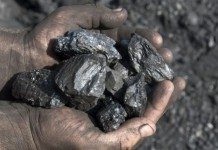
[miningmx.com] — URANIUM One shares surged 6.2% in trading on the JSE on Tuesday to hit a new 12-month high of R46.30 in response to the rising price of uranium.
The uranium spot price hit US$$70/lb last week which is 75% up on the levels around $40/lb that ruled in May last year.
In marked contrast the JSE’s other listed uranium producer – First Uranium – dropped nearly 4% to 749c heading back towards its 12-month low of 525c after rallying to around R10 early in December.
First Uranium announced on January 27 that it would need to raise an unspecified amount of funds to meet working capital requirements following further production problems at its Ezulwini mine.
The company raised US$150m last April to deal with a financial crisis caused by production problems at Ezulwini and the withdrawal of a key environmental permit for its Mine Waste Solution (MWS) operation which delayed planned expansions there.
The uranium price is being driven up because of rising demand from the “nuclear renaissance’ – as nuclear reactors come back into favour for power generation – coupled with concerns over supply shortfalls in the medium term.
Latest research from analyst Warwick Grigor at Australian firm BGF Equities released on Tuesday said that “a sustainable price range for 2011 is $60/lb to $80/lb which is the level needed to encourage the supply response the nuclear industry is looking for.
“Below that level there will be reluctance to make supply available as debt finance will be too difficult and equity funding will be scarce.
“Rises above $80/lb will be destabilising as speculators will start to dominate the market again and this will spook financiers whilst encouraging projects of dubious long-term merit’, Grigor added.
A looming “crunch’ factor in the market is the end of the deal through which highly enriched uranium (HEU) has been provided to the nuclear power generation industry from decommissioned Russian nuclear weapons.
That secondary supply has kept the uranium price depressed for the past 20 years except for the short-term spike in 2007/2008 when the price soared to $136/lb.
Another Australian firm – Resource Capital Research (RCR) – said in a December report that there were now 441 nuclear reactors in operation and 58 under construction while another 479 new nuclear reactors were either planned or proposed around the world.
As of November, 159 of those proposed reactors were to be built in China and Grigor commented that, “Chinese activity in the nuclear fuel market is creating anxiety amongst other nuclear power countries which have allowed three years of falling uranium prices to foster complacency.
“There is strong competition for supply which is underpinning the price, both in spot and long-term contracts. “
Grigor noted that the Russians were also becoming more aggressive in the uranium space; “securing control of Uranium One, bidding $10/lb with the takeover bid for Mantra Resources, seeking to gain control of Berkley Resources ahead of its deal with the Koreans and providing finance for mine developments.’
State-owned Russian uranium company ARMZ now controls Uranium One after the deal through which it injected uranium mining assets in Kazakhstan into Uranium One to take a 50% stake in the company.
Grigor added, “China is seeking to build strategic stockpiles and it realises it has to buy now rather than pursue a “just-in-time’ approach. It has effectively shifted the demand curve forward in time.
“Competition is building between Russia and China to secure long term uranium supplies looking at 10 to 12 year time frames.
“Speculators have renewed confidence in the uranium spot price knowing that the Chinese buying will provide a floor and they are prepared to front-run real buyers.
“Unless new mines are brought on stream rapidly over the next two years there will be a serious shortage of supply when the conversion of weapons grade to power grade (uranium) expires.’
According to Grigor, the HEU deal provides some 24m lbs of uranium annually at present.
The surge in the uranium price has sent uranium company share prices flying particularly for companies listed on the ASX and TSX but with the notable exception of First Uranium.
There are two major uranium projects in South Africa currently under consideration – Rand Uranium in which Harmony has a 40% stake – and Gold Fields which is planning to recover uranium from mine dumps at its Kloof and Driefontein mines.











